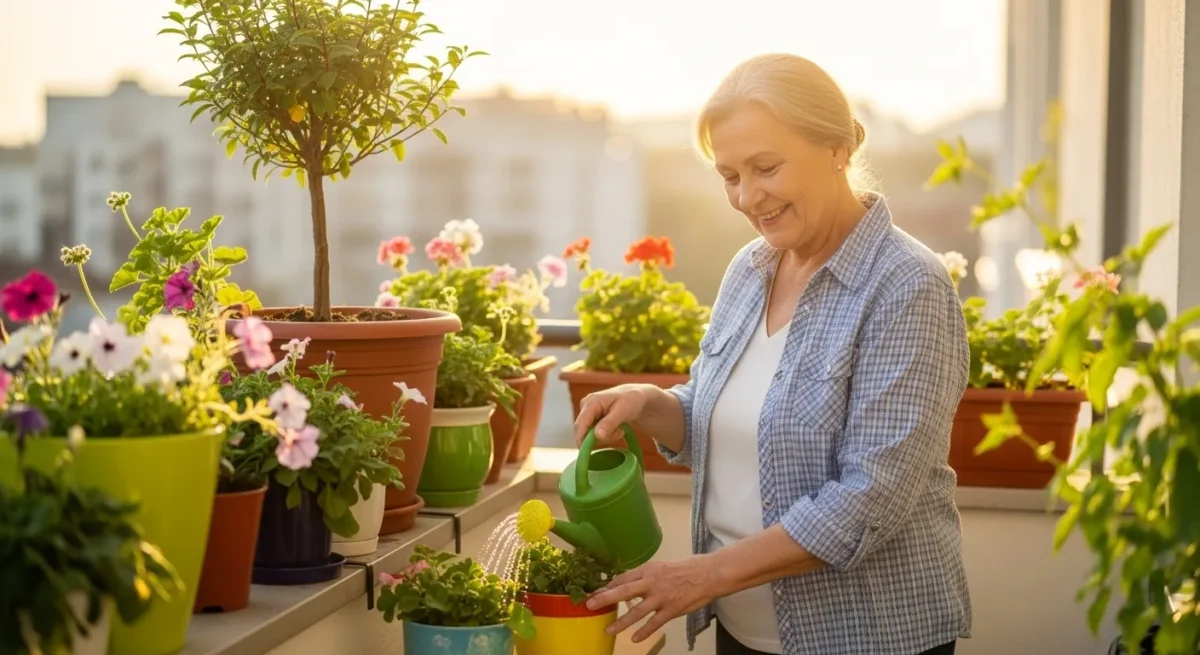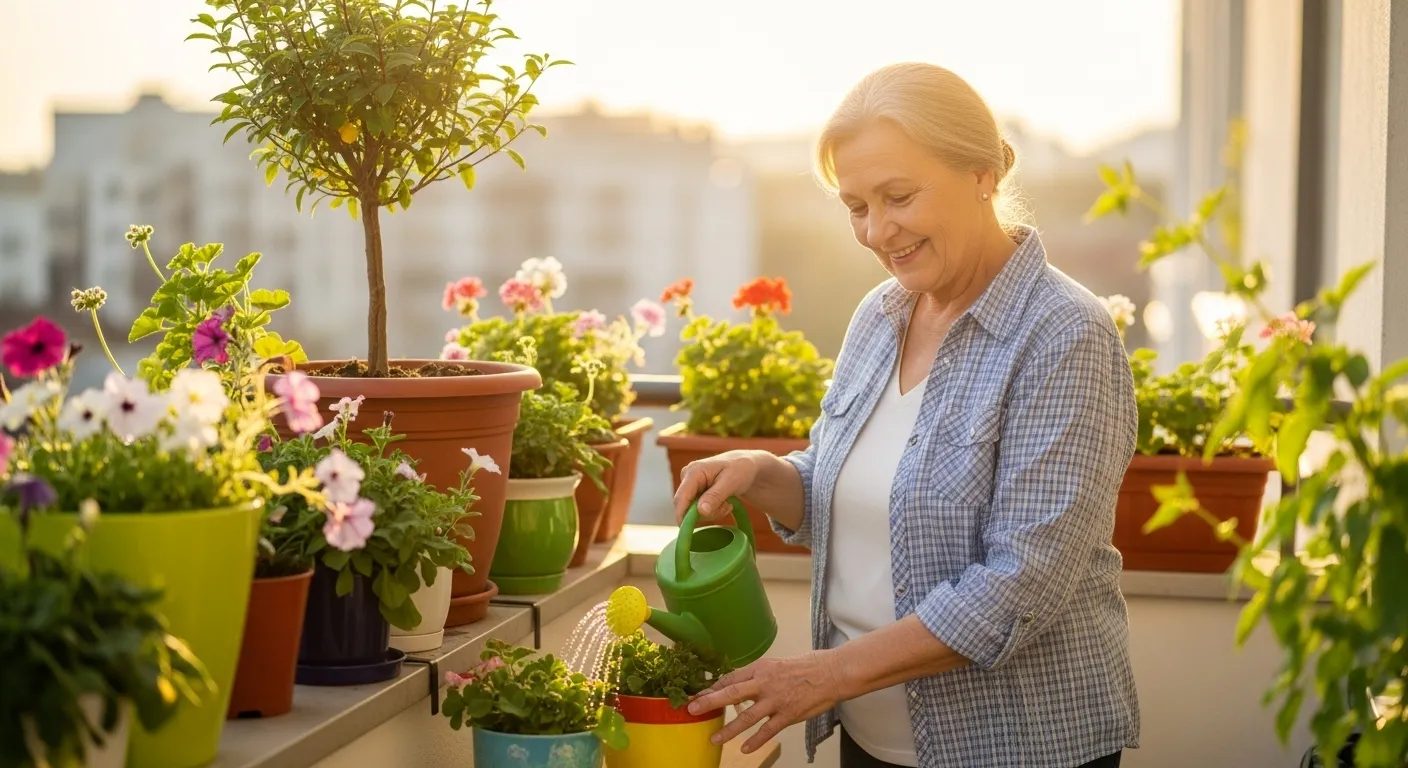
Gardening offers immense joy, a connection to nature, and the satisfaction of nurturing life. For seniors, it provides a wonderful way to stay active, engage the mind, and enjoy fresh produce or beautiful blooms. However, traditional gardening can sometimes involve strenuous tasks like bending, heavy lifting, and extensive weeding, which may become challenging over time. This is where container gardening shines as an ideal solution. It brings the garden up to you, reducing physical strain and simplifying care.
Container gardening provides unparalleled flexibility. You transform small spaces, like balconies, patios, or even a sunny windowsill, into thriving green oases. You control the soil, water, and sun exposure with precision, ensuring your plants receive exactly what they need without the constant battle against garden pests or poor soil quality often found in traditional garden beds. Moreover, it empowers you to cultivate your favorite plants with ease, making gardening a truly accessible and rewarding hobby at any age.

Why Container Gardening is Perfect for Seniors
Container gardening addresses many common challenges seniors face with traditional gardening methods, transforming it into a more accessible and enjoyable activity. You gain significant control over your gardening environment, which directly translates to less physical effort and greater success.
Reduced Physical Strain
One of the primary benefits of container gardening for seniors involves significantly reduced physical strain. When you garden in containers, you eliminate much of the bending, kneeling, and heavy digging associated with in-ground beds. You can place containers on raised stands, tables, or even waist-high planters, bringing the work to a comfortable level. This minimizes stress on your back, knees, and joints. A study published in the Journal of Horticultural Science & Biotechnology highlights how gardening, when adapted for accessibility, contributes positively to physical activity and mental well-being in older adults.
Mobility and Flexibility
Unlike fixed garden beds, containers offer incredible mobility. You move them to optimize sun exposure throughout the day, shelter them from harsh weather, or bring them indoors during cold snaps. This flexibility ensures your plants thrive while also adapting to your changing needs or preferences. Imagine moving a heavy pot. Lightweight planters, made from materials like plastic or fabric, make this task far easier. This adaptability makes container gardening an excellent choice for those with limited mobility or fluctuating energy levels.
Space Efficiency
Limited space presents no barrier to a vibrant container garden. Balconies, patios, small yards, and even windowsills become fertile ground for growing. You maximize vertical space using tiered planters or hanging baskets, creating a lush garden in a surprisingly compact area. This efficiency allows you to enjoy the benefits of gardening even if you live in an apartment or condominium, proving that big gardening dreams fit into small footprints.
Better Control Over Growing Conditions
You exert precise control over your plants’ environment in containers. You choose the exact type of potting mix, tailoring it to your plants’ specific needs. This prevents issues like compacted native soil or nutrient deficiencies. Additionally, you manage watering with greater accuracy, preventing both overwatering and underwatering, two common pitfalls for new gardeners. This level of control significantly increases your chances of plant success, fostering a sense of accomplishment and reducing frustration.
Therapeutic and Mental Benefits
Beyond the physical advantages, container gardening offers substantial mental and emotional benefits for seniors. Engaging with plants reduces stress, improves mood, and provides a sense of purpose. The act of nurturing a plant from seed to harvest, or from a small seedling to a mature, blooming specimen, offers immense satisfaction. It stimulates cognitive function, encourages problem-solving, and provides a gentle form of exercise. The vibrant colors, fragrant aromas, and fresh tastes derived from your garden invigorate the senses and enhance overall quality of life. Research consistently demonstrates gardening’s positive impact on mental health, reducing symptoms of anxiety and depression.
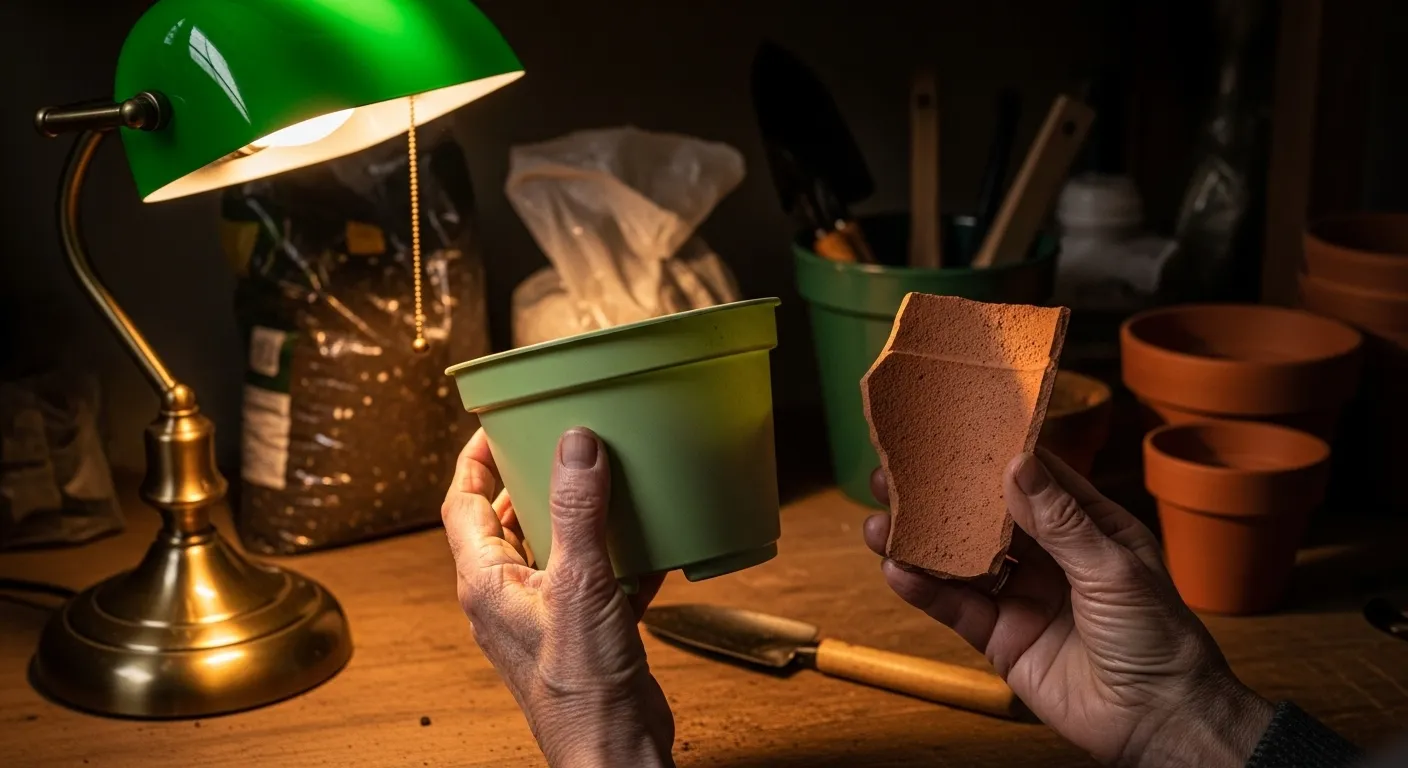
Choosing the Right Containers and Location
Selecting the correct containers and placing them strategically forms the foundation of a successful, low-maintenance container garden. Consider both your physical capabilities and your plants’ needs during this crucial planning stage.
Container Materials and Size: Think Lightweight Planters
Your choice of container material directly impacts ease of maintenance. When choosing containers, prioritize options that are manageable to move and sturdy enough for your plants. Traditional terracotta pots, while beautiful, become extremely heavy once filled with soil and water, and they are prone to breaking. They also dry out quickly, requiring more frequent watering.
Instead, consider these excellent alternatives:
- Plastic or Resin Pots: These are affordable, durable, and significantly lighter than terracotta. They retain moisture well, reducing your watering frequency. Many modern plastic planters mimic the look of more expensive materials, offering aesthetics without the weight.
- Fabric Grow Bags: Made from breathable, heavy-duty fabric, grow bags offer excellent drainage and air circulation, promoting healthier root systems. They are incredibly lightweight, easy to store when empty, and often come with handles for effortless repositioning.
- Lightweight Composite or Fiberglass: These options offer the look of ceramic or stone without the considerable weight. They are an excellent investment for larger plants where a substantial visual presence is desired without the lifting challenge.
- Self-Watering Containers: These innovative planters feature a water reservoir at the bottom, wicking moisture up to the plant roots as needed. They dramatically reduce the frequency of watering, making them a top choice for low-maintenance container gardening seniors.
Beyond material, size matters. Choose containers large enough to accommodate your plant’s mature root system. Smaller pots dry out faster and restrict root growth, leading to stressed plants and more frequent watering. For most vegetables and flowering plants, a pot with at least an 8-12 inch diameter is a good starting point. Deeper pots are essential for root vegetables or larger plants like tomatoes.
Ensuring Proper Drainage
Regardless of the material, every container absolutely requires drainage holes at the bottom. Drainage allows excess water to escape, preventing waterlogged soil which suffocates roots and leads to rot. If your chosen container lacks holes, drill several 1/2-inch holes yourself. Do not add a layer of gravel or broken pottery at the bottom of the pot. This common myth actually hinders drainage, creating a perched water table that keeps the soil above it too wet. Simply use a good quality potting mix directly over the drainage holes.
Strategic Placement: Location, Location, Location
Where you place your containers determines their success. Evaluate your chosen location based on sunlight, accessibility, and proximity to a water source.
- Sunlight Requirements: Most flowering plants and vegetables require at least 6-8 hours of direct sunlight daily. Observe your space throughout the day to identify areas that receive adequate sun. If your space is mostly shaded, select plants that tolerate lower light conditions, such as impatiens, begonias, or leafy greens.
- Accessibility: Place containers where you can easily reach them for watering, pruning, and harvesting without excessive bending or stretching. Utilize tables, benches, or wheeled caddies to raise containers to a comfortable working height. This accessibility is paramount for container gardening seniors.
- Water Source Proximity: Hauling watering cans across long distances becomes tiresome. Position your garden near an outdoor spigot or a convenient water source. Consider investing in a lightweight hose with an adjustable nozzle, or even a simple drip irrigation system, to simplify watering.

Selecting Easy Plants for Senior Gardeners
The key to enjoyable container gardening, especially for seniors, lies in choosing resilient, low-maintenance plants. Focus on varieties that thrive in containers, require minimal fuss, and offer a continuous harvest or bloom.
Foolproof Vegetables for Containers
Growing your own food is incredibly rewarding, and many vegetables adapt beautifully to container life. When choosing vegetables for container gardening seniors, look for “bush” or “dwarf” varieties specifically bred for compact growth.
- Lettuce and Leafy Greens: Varieties like loose-leaf lettuce, spinach, and Swiss chard are incredibly easy to grow. They prefer partial shade, making them suitable for less sunny spots, and you harvest outer leaves continuously for weeks.
- Bush Beans: Unlike pole beans, bush beans do not require elaborate trellising. They grow compactly and produce abundant harvests. Look for varieties like ‘Blue Lake Bush’ or ‘Provider’.
- Cherry Tomatoes: While full-sized tomatoes need large containers and staking, determinate bush cherry tomato varieties, such as ‘Patio’ or ‘Tiny Tim’, are perfect for pots. They produce sweet, bite-sized fruit with less support.
- Radishes: These quick-growing root vegetables mature in just 3-4 weeks. Plant them in succession for a continuous supply.
- Herbs: Basil, mint (in its own pot to prevent spreading), parsley, chives, and oregano thrive in containers. They require minimal care and provide fresh flavor for your cooking. Place them near your kitchen door for easy access.
- Peppers: Bell peppers and chili peppers are excellent container candidates. They enjoy warm weather and produce a steady yield. Look for compact varieties.
Resilient Flowers for Continuous Bloom
Flowers add vibrant color and beauty, attracting pollinators and lifting spirits. Select long-blooming, sturdy varieties that do not demand constant deadheading or specialized care.
- Marigolds: These cheerful annuals come in shades of orange, yellow, and red. They are incredibly tough, tolerant of heat, and known to deter some garden pests.
- Petunias: Modern petunia varieties, especially ‘Wave’ or ‘Supertunia’ types, are vigorous growers that cascade beautifully over container edges. Many are “self-cleaning,” meaning you do not need to deadhead spent blooms.
- Impatiens (New Guinea or Sunpatiens): Traditional impatiens prefer shade, but New Guinea impatiens tolerate more sun. Sunpatiens thrive in full sun and offer continuous blooms in various colors. These provide consistent color without much effort.
- Begonias: Both fibrous and tuberous begonias offer spectacular blooms and foliage. Fibrous begonias perform well in partial to full shade, while sun-tolerant varieties are also available. They are quite low-maintenance.
- Zinnias: Easy to grow from seed, zinnias provide bright, long-lasting blooms that attract butterflies. They are relatively drought-tolerant once established and make excellent cut flowers.
- Geraniums (Pelargoniums): These classic container plants offer abundant blooms and tolerate a bit of neglect. They come in many colors and are surprisingly resilient.
Considering Your Climate
Always choose plants suited to your specific climate zone. Your local nursery or garden center will stock plants that thrive in your area. Additionally, read plant tags carefully; they provide crucial information on light, water, and space requirements. Many plant nurseries now label plants as “easy care” or “drought tolerant,” which helps container gardening seniors make excellent choices.
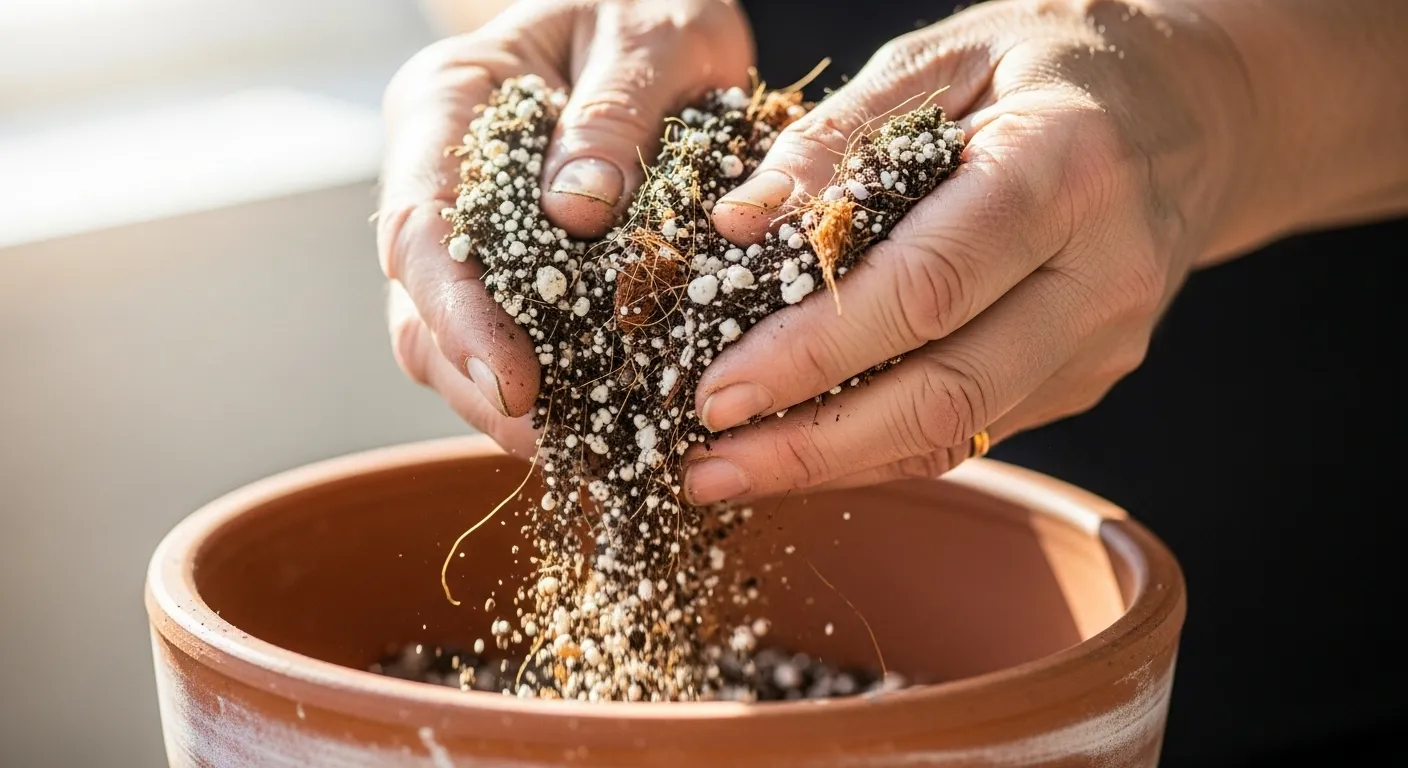
Essential Soil and Watering Strategies
The success of your container garden heavily relies on the quality of your potting mix and a consistent, appropriate watering routine. Understanding these fundamentals simplifies care and promotes robust plant growth.
Choosing the Right Potting Mix
Never use garden soil directly from your yard in containers. Garden soil is too heavy, compacts easily in pots, and often contains weed seeds and pests. Instead, invest in a high-quality, lightweight potting mix specifically formulated for containers.
- Potting Mix vs. Potting Soil: Look for “potting mix” on the bag. This term typically indicates a soilless blend designed for containers. It usually contains ingredients like peat moss, coco coir, vermiculite, and perlite. These materials provide excellent aeration, allowing roots to breathe, and superior drainage, preventing waterlogging. They also hold moisture and nutrients effectively, reducing your watering and feeding frequency.
- Key Qualities to Look For:
- Good Drainage: This means water moves easily through the soil without pooling. Ingredients like perlite create air pockets, preventing roots from suffocating.
- Moisture Retention: While draining well, the mix must also hold enough moisture to keep plants hydrated between waterings. Coco coir and peat moss excel at this.
- Lightweight: A lighter mix makes moving containers easier, a significant advantage for container gardening seniors.
- Nutrient Content: Many potting mixes include a slow-release fertilizer, providing initial nutrients to your plants and reducing the need for immediate additional feeding.
- Specialized Mixes: For specific plants, you might consider specialized mixes, such as those for succulents (which drain extremely quickly) or for acid-loving plants like blueberries. However, a good all-purpose potting mix works well for most vegetables and flowers.
When filling containers, leave about one inch of space between the soil surface and the rim of the pot. This “headroom” prevents water and soil from overflowing when you water your plants.
Mastering the Art of Watering
Watering is the most frequent task in container gardening. However, smart strategies significantly reduce the effort involved.
How to Tell When to Water:
The most reliable method is to feel the soil. Stick your finger about two inches deep into the potting mix. If it feels dry, it is time to water. If it feels moist, wait. This simple test prevents both overwatering and underwatering, common causes of plant stress.
Proper Watering Technique:
Water thoroughly until you see water draining from the bottom holes of the container. This ensures moisture reaches all the roots. If water runs out immediately, the soil might be too dry and compacted. In this case, water a little, wait 15 minutes for the soil to absorb, then water again thoroughly. This process is often called “bottom watering” when you set the pot in a saucer of water.
Factors Affecting Watering Frequency:
- Weather: Hot, sunny, and windy days dry out pots much faster than cool, cloudy days. You may need to water daily or even twice daily during heatwaves.
- Container Material: Terracotta pots dry out faster than plastic or glazed pots. Fabric grow bags also promote evaporation, requiring more frequent watering.
- Plant Size: Larger plants with extensive root systems consume more water than smaller plants.
- Type of Plant: Some plants, like succulents, prefer drier conditions, while others, such as impatiens, demand consistently moist soil.
Low-Effort Watering Solutions:
- Self-Watering Containers: As mentioned, these are a game-changer. They provide a consistent water supply for days or even weeks, drastically reducing your watering chore.
- Watering Wands: Attach a long watering wand to your hose. This allows you to reach hanging baskets and distant pots without bending or lifting a heavy watering can.
- Drip Irrigation Systems: For larger container gardens, a simple drip irrigation system delivers water directly to the plant roots. These systems are surprisingly easy to install, often connect to a timer, and significantly conserve water.
- Watering Globes/Spikes: While not as efficient as self-watering containers, these devices release water slowly into the soil over a few days, offering a temporary solution for short trips or busy periods.
Adopting these soil and watering strategies empowers you to create a thriving container garden with minimal effort, ensuring your plants remain healthy and productive.
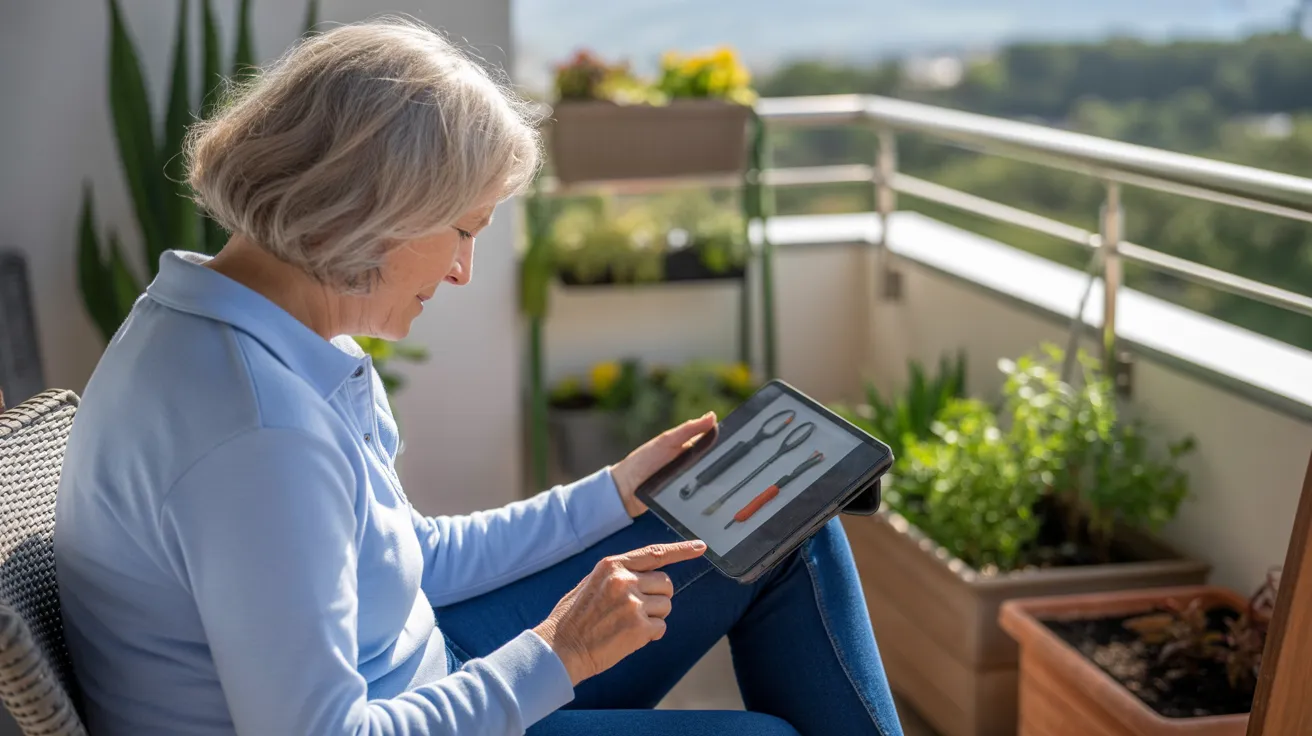
Tools and Techniques for Accessible Gardening
Smart tools and adapted techniques make gardening far more enjoyable and less strenuous. Investing in ergonomic equipment and adopting clever approaches ensures container gardening remains a delightful hobby for seniors.
Ergonomic and Lightweight Tools
Traditional garden tools can be heavy, cumbersome, and difficult to grip. Modern ergonomic tools feature design improvements that reduce strain and improve comfort.
- Ergonomic Hand Tools: Look for trowels, cultivators, and weeders with comfortable, padded handles that fit well in your hand. Many feature angled designs to keep your wrist in a neutral position, reducing wrist and arm fatigue.
- Long-Handled Tools: Extend your reach without bending. A long-handled trowel or a stand-up weeder allows you to tend to pots on the ground or in raised beds more easily.
- Lightweight Watering Cans and Hoses: Opt for smaller, plastic watering cans or a lightweight coiled hose that expands when in use and shrinks for easy storage. A hose with an adjustable nozzle provides different spray patterns for gentle watering.
- Bypass Pruners: Choose pruners with a spring-loaded mechanism and comfortable grips. Bypass pruners create clean cuts, essential for plant health, and require less hand strength than anvil pruners.
- Seed Sowers and Dibbers: These small tools simplify planting seeds and creating planting holes without fiddly finger work.
Mobility Aids and Raised Planting Solutions
Bringing the garden to your level eliminates the need for excessive bending, kneeling, or heavy lifting.
- Rolling Garden Seats or Carts: A wheeled garden seat allows you to roll along your containers while seated, reaching plants without standing up. Many models include storage for tools. Similarly, utility carts with wheels help transport soil bags, pots, and tools with minimal effort.
- Knee Pads or Garden Kneelers: If you prefer to kneel, invest in thick, comfortable knee pads or a garden kneeler. Some kneelers double as a seat when flipped over, offering dual functionality.
- Raised Garden Beds for Containers: While this article focuses on individual containers, consider placing your containers within a waist-high raised garden bed. This brings all your plants to a comfortable working height and centralizes your container garden.
- Container Dollies or Caddies: For larger, heavier pots that you need to move occasionally, a wheeled container dolly or caddy allows you to reposition them effortlessly.
- Potting Benches or Tables: A dedicated potting bench or sturdy table provides a comfortable height for mixing soil, transplanting, and working with smaller containers. This keeps tools organized and prevents clutter.
Smart Gardening Techniques
Beyond tools, adopting specific techniques further minimizes effort and maximizes enjoyment.
- Container Grouping: Grouping containers together creates a microclimate, helping to retain humidity and reduce drying out. This also makes watering more efficient, as you address several plants in one spot. Ensure adequate air circulation to prevent fungal issues.
- Mulching Containers: A layer of mulch, such as wood chips, shredded leaves, or straw, on top of the soil in your containers significantly reduces moisture evaporation. This means you water less frequently. Mulch also helps regulate soil temperature and suppresses weeds.
- Planting for Accessibility: When arranging plants, place taller plants at the back or center of the container, and trailing plants at the edges. Ensure all plants are easily reachable for watering, pruning, and harvesting. Avoid planting too densely, as this restricts airflow and makes maintenance harder.
- Pruning and Deadheading: Regular light pruning and deadheading (removing spent flowers) encourages more blooms and healthier plant growth. Do this often with your ergonomic pruners, removing issues before they become major problems. Small, frequent tasks are less strenuous than large, infrequent ones.
- Succession Planting: For vegetables like lettuce or radishes, plant a small batch every 2-3 weeks instead of planting everything at once. This ensures a continuous, manageable harvest without overwhelming you with too much produce at one time.
By thoughtfully choosing your tools and employing these accessible gardening techniques, you transform container gardening into a highly enjoyable and sustainable hobby, regardless of physical limitations.
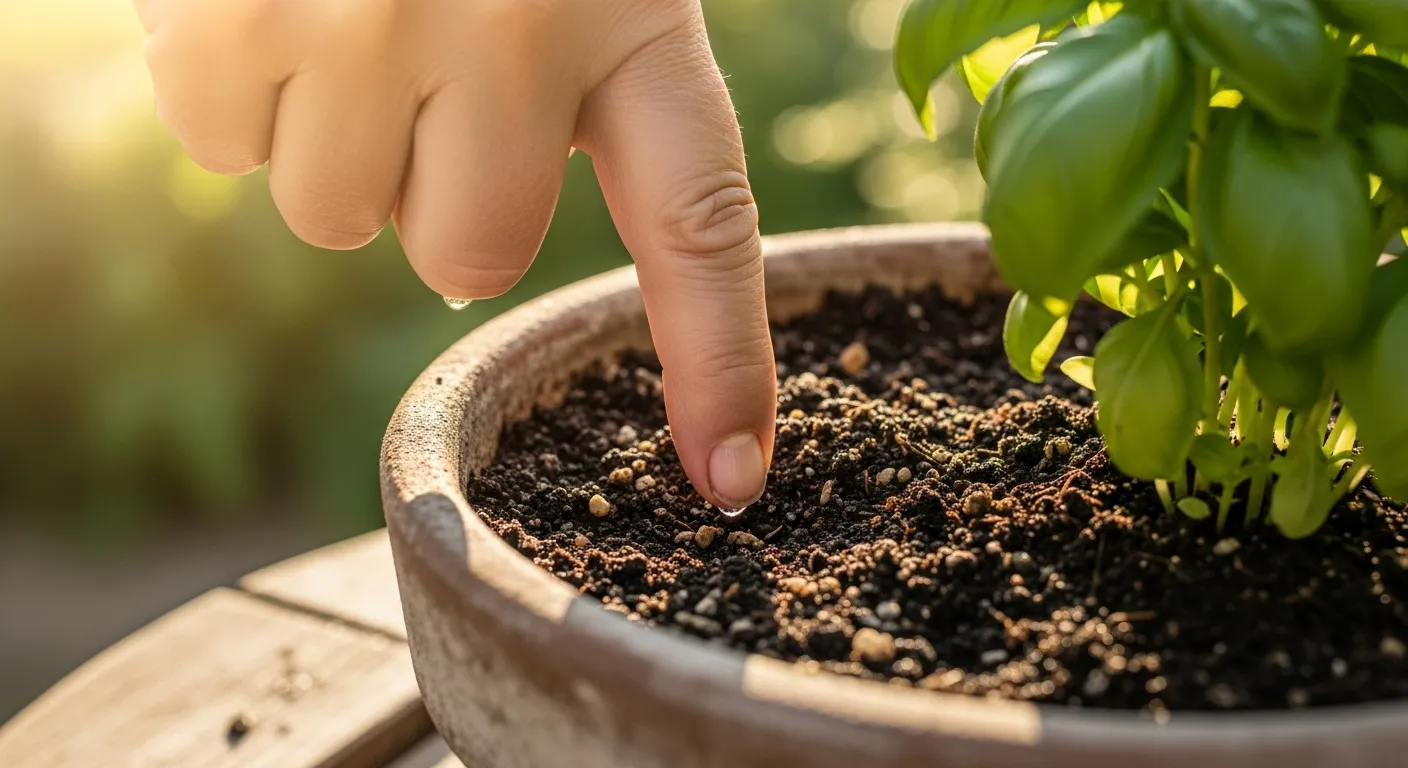
Pest Management and Plant Health Without the Hassle
Dealing with pests and diseases becomes daunting if you let problems escalate. For low-maintenance container gardening, prevention and early intervention using simple, eco-friendly methods are key. You will protect your plants without resorting to complex or harmful chemicals.
Building Healthy, Resilient Plants
A healthy plant naturally resists pests and diseases better than a stressed one. Focus on providing optimal conditions:
- Right Plant, Right Place: Choose plants suited to your light conditions and local climate. A plant struggling in too much or too little sun is a prime target for pests.
- Quality Potting Mix: Use a well-draining, nutrient-rich potting mix. Healthy roots lead to healthy foliage.
- Proper Watering: Avoid both overwatering (which encourages root rot and fungal issues) and underwatering (which stresses plants, making them vulnerable). Follow the “finger test” religiously.
- Good Air Circulation: Space your containers adequately. If plants are too crowded, humidity builds up, fostering fungal diseases. Prune away dense foliage to improve airflow.
- Nutrient Balance: Provide appropriate nutrients through a slow-release fertilizer in the potting mix or occasional liquid feeding. Over-fertilizing, especially with nitrogen, can lead to lush, tender growth that attracts sap-sucking insects.
Simple, Non-Toxic Pest Solutions
When pests do appear, address them promptly with gentle methods. Early detection prevents major infestations.
- Hand-Picking: For larger pests like slugs, snails, or caterpillars, simply pick them off and dispose of them. Do this in the early morning or evening when many pests are most active.
- Strong Water Spray: A strong spray of water from a hose dislodges aphids, spider mites, and whiteflies from plant leaves. Repeat every few days until the pests are gone. This method is effective and completely non-toxic.
- Insecticidal Soap: For persistent outbreaks of soft-bodied insects like aphids, mealybugs, or spider mites, an insecticidal soap spray is highly effective. It smothers pests without harming beneficial insects or the environment. Mix it according to package directions and spray all affected plant surfaces, including undersides of leaves. You can purchase commercial insecticidal soap or make your own with a few drops of mild dish soap (avoid detergents) mixed with water. Always test a small area of the plant first.
- Neem Oil: Derived from the neem tree, neem oil acts as an insect repellent and growth regulator, disrupting the life cycle of many pests. It also has some fungicidal properties. Use it as a preventative spray or to treat existing infestations, following product instructions carefully.
- Companion Planting: Some plants naturally deter pests. Planting marigolds near your vegetables can help repel nematodes and other insects. Nasturtiums attract aphids away from other plants, acting as a “trap crop.”
- Physical Barriers: For some crops, lightweight floating row covers physically block pests from reaching your plants while still allowing light and water through.
Recognizing and Addressing Common Plant Issues
Familiarize yourself with common signs of plant distress:
- Yellowing Leaves: This often indicates overwatering, underwatering, or a nutrient deficiency. Check soil moisture first.
- Wilting: Usually a sign of thirst. Check soil moisture. If soil is wet and leaves still wilt, it might be root rot.
- Brown or Crispy Leaf Edges: Often due to underwatering, excessive heat, or low humidity.
- Spots on Leaves: Could indicate a fungal disease. Improve air circulation, remove affected leaves, and consider a natural fungicide like diluted neem oil.
By regularly inspecting your plants (a quick check during watering works well), you catch problems early. A healthy, well-cared-for plant resists most issues, making pest and disease management a straightforward part of your low-maintenance container gardening routine.
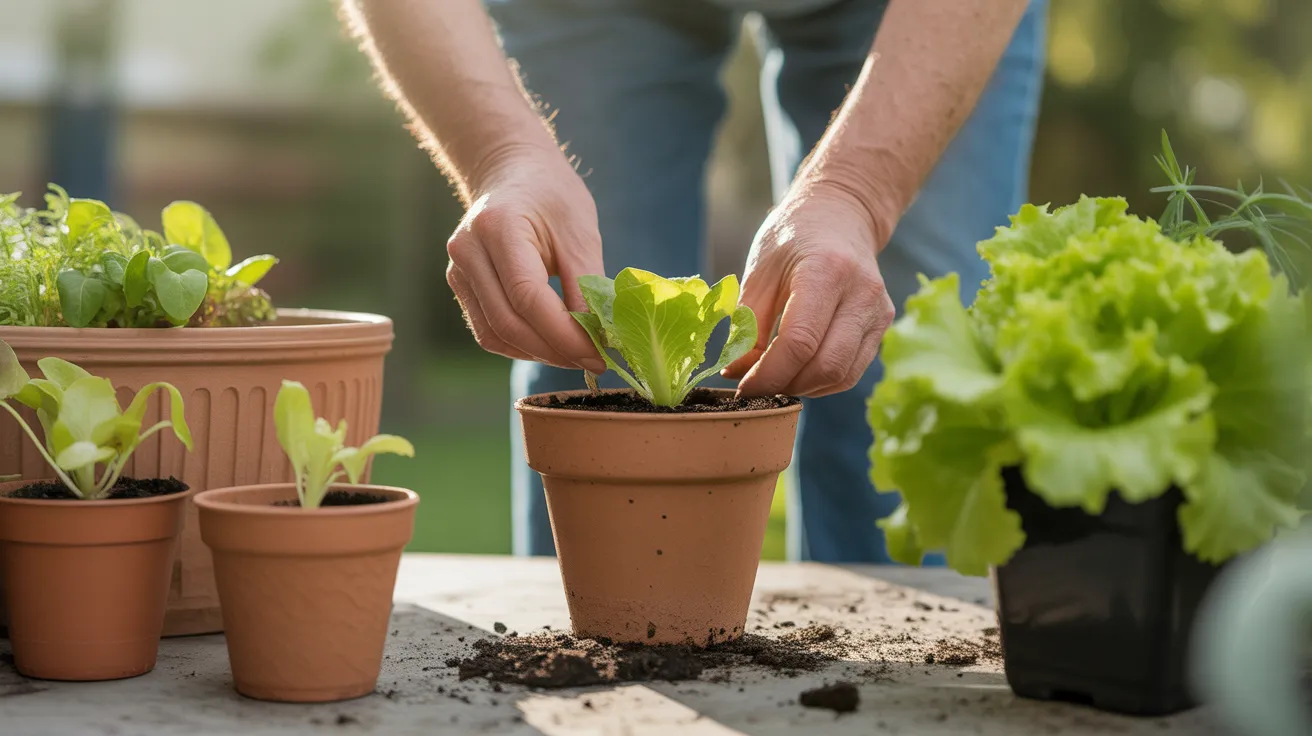
Extending Your Growing Season
Maximizing your harvest and enjoyment means making the most of your gardening year. Even in containers, you easily extend your growing season, enjoying fresh produce and vibrant blooms for longer periods. This approach helps container gardening seniors get more out of their efforts.
Succession Planting
Succession planting involves making smaller, staggered plantings every few weeks instead of sowing an entire crop at once. This ensures a continuous harvest rather than a single, overwhelming bounty.
- For Fast-Growing Crops: Ideal for leafy greens (lettuce, spinach), radishes, bush beans, and herbs. Plant a small batch every 2-3 weeks from early spring until mid-to-late summer.
- Benefit: You get a steady supply of fresh produce, prevent gluts, and spread out your harvesting tasks. If one planting fails, you have others coming along.
Cool-Season and Warm-Season Crops
Understanding which plants thrive in different temperatures allows you to tailor your planting schedule.
- Early Spring and Fall (Cool-Season): Plant crops that tolerate cooler temperatures and even light frosts. Examples include lettuce, spinach, kale, Swiss chard, radishes, peas, and many herbs. You can start planting these weeks before the last frost date in spring and continue well into fall.
- Summer (Warm-Season): Once the danger of frost passes and temperatures consistently warm up, plant heat-loving crops like tomatoes, peppers, bush beans, basil, and most flowering annuals.
- Transitioning: As summer heat arrives, pull out any bolting (going to seed) cool-season crops and replace them with warm-season varieties. In late summer, as temperatures begin to drop, replace spent warm-season plants with a new round of cool-season vegetables for a fall harvest.
Utilizing Season Extenders
Simple tools provide extra protection from cold or extend warmth, allowing you to plant earlier and harvest later.
- Cloches: These bell-shaped covers (made from glass, plastic, or even repurposed milk jugs) protect individual plants from light frost and cold winds. They trap warmth around the plant.
- Cold Frames: A cold frame is essentially a bottomless box with a transparent lid. You place it over a group of containers or directly plant inside it. It acts like a mini-greenhouse, significantly warming the soil and air, allowing you to grow cool-season crops earlier in spring and later into fall. Many ready-made cold frames are lightweight and portable.
- Mini-Greenhouses: Small, portable greenhouses, often with shelving, provide a protected environment for starting seeds, hardening off seedlings, or extending the life of cold-sensitive plants. They are relatively inexpensive and easy to assemble.
- Floating Row Covers: Lightweight fabric covers draped over plants provide protection from light frost, cold winds, and even some insect pests. They allow light and water to pass through and lift easily for plant access.
Bringing Plants Indoors for Winter
For some plants, especially herbs and certain flowers, you extend their life by moving them indoors before the first hard frost.
- Herbs: Basil, rosemary, mint, and chives often do well indoors if given adequate light (a sunny window or grow light). Pot them up or move existing container plants.
- Flowers: Geraniums, begonias, and fuchsias can be overwintered indoors. Some gardeners even bring in small pepper or tomato plants to continue harvesting a bit longer.
- Preparation: Before bringing plants indoors, inspect them thoroughly for pests. Prune back any leggy growth and ensure the pot has good drainage.
By implementing these strategies, you make your container garden a year-round source of beauty and bounty, enhancing the enjoyment and productivity of your efforts for container gardening seniors.
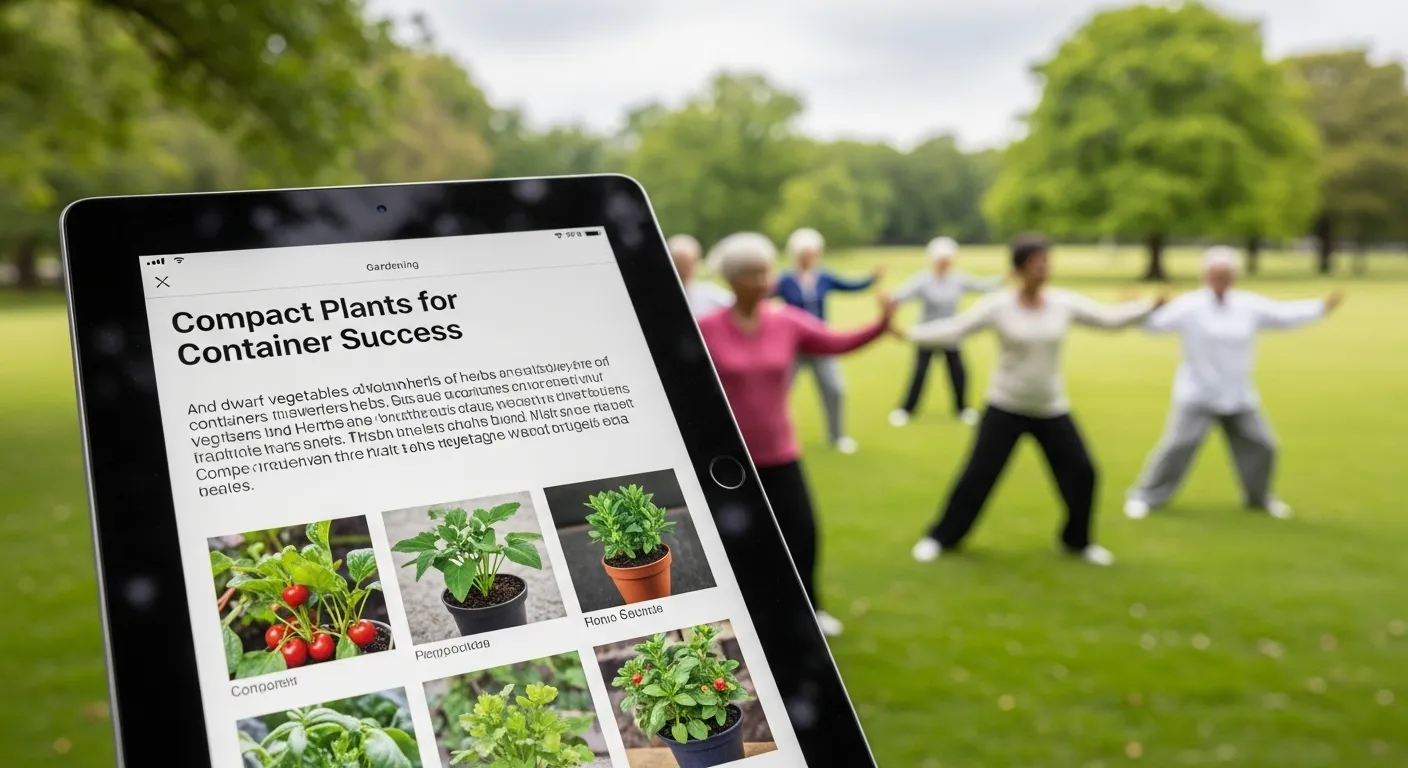
Frequently Asked Questions
Can I grow anything in a container?
Almost! While containers are incredibly versatile, successful growth depends on choosing plants suited to container life. Look for “dwarf,” “bush,” or “compact” varieties of vegetables and fruits. Consider the mature size of the plant’s root system versus the container size. Most herbs, leafy greens, small root vegetables, many annual flowers, and even some small fruit trees like dwarf citrus or blueberries thrive in appropriate containers. You must provide enough space for roots to grow, and adequate drainage, to ensure plant health.
How often do I need to fertilize my container plants?
Container plants need more frequent fertilization than in-ground plants because nutrients leach out with each watering. If your potting mix contains a slow-release fertilizer, your plants have enough food for the first few weeks. After that, begin a regular feeding schedule. For most plants, a diluted liquid fertilizer every 2-4 weeks during the active growing season (spring and summer) works well. Always follow the product’s instructions, and avoid over-fertilizing, which can burn roots. Reduce or stop fertilizing during fall and winter when plant growth slows.
What if I have limited sun on my balcony or patio?
Limited sun is not a barrier to container gardening. Many plants thrive in partial shade (3-6 hours of direct sun) or even full shade (less than 3 hours of direct sun). For edible plants, focus on leafy greens like lettuce, spinach, kale, Swiss chard, and some herbs like mint, parsley, and cilantro. For flowers, impatiens, begonias, fuchsias, hostas, and some ferns provide beautiful color and texture in shadier spots. You simply choose the right plants for your available light, ensuring successful growth.
How do I overwinter my container plants?
Overwintering strategies depend on your climate and plant type. For tender annuals, you usually let them complete their life cycle and replace them next season. Hardy perennials and shrubs in containers often survive winter outdoors in milder climates, especially if you move them to a sheltered spot, group them for insulation, or wrap pots in burlap. In colder zones, you bring tender plants like geraniums, non-hardy herbs, or small fruit trees indoors before the first hard frost. Give them a sunny window or grow light, reduce watering, and stop fertilizing until spring. Always research the specific needs of your plants.
Are self-watering containers truly low-maintenance?
Yes, self-watering containers significantly reduce the frequency of watering, making them a top choice for low-maintenance container gardening seniors. They feature a reservoir that wicks water up to the soil as needed, providing a consistent moisture level for plants. You refill the reservoir less often than you would top-water a traditional pot. However, they are not entirely maintenance-free. You still need to refill the reservoir, fertilize, monitor for pests, and sometimes flush the soil to prevent salt buildup. They represent a substantial step towards simplifying daily care, but they require periodic attention.
For trustworthy gardening information, visit: University of Minnesota Extension, Royal Horticultural Society (RHS), Cornell Garden-Based Learning and UF/IFAS Gardening Solutions. These organizations provide expert, research-based advice for gardeners at all levels.
Disclaimer: This article is for informational purposes only and is not a substitute for professional gardening advice. Always consult local extension services or horticulture experts for region-specific guidance.
